
Reversi is a strategy board game for two players, played on an 8×8 uncheckered board. It was invented in 1883. Othello, a variant with a fixed initial setup of the board, was patented in 1971.
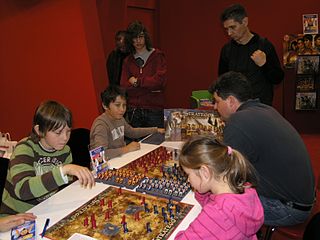
Stratego is a strategy board game for two players on a board of 10×10 squares. Each player controls 40 pieces representing individual officer and soldier ranks in an army. The pieces have Napoleonic insignia. The objective of the game is to either find and capture the opponent's Flag or to capture so many enemy pieces that the opponent cannot make any further moves. Stratego has simple enough rules for young children to play but a depth of strategy that is also appealing to adults.
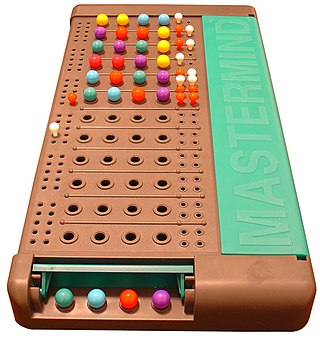
Mastermind or Master Mind is a code-breaking game for two players invented in Israel. It resembles an earlier pencil and paper game called Bulls and Cows that may date back a century.

Trouble is a board game in which players compete to be the first to send four pieces all the way around a board. It is based on a traditional game called "Frustration" played on a wooden board with indentations for marble playing pieces and rules similar to Parcheesi. Pieces are moved according to the roll of a die using a contained device called a "Pop-O-Matic".

TwixT is a two-player strategy board game, an early entrant in the 1960s 3M bookshelf game series. It became one of the most popular and enduring games in the series. It is a connection game where players alternate turns placing pegs and links on a pegboard in an attempt to link their opposite sides. While TwixT itself is simple, the game also requires strategy, so young children can play it, but it also appeals to adults. The game has been discontinued except in Germany and Japan.

Battleship is a strategy type guessing game for two players. It is played on ruled grids on which each player's fleet of warships are marked. The locations of the fleets are concealed from the other player. Players alternate turns calling "shots" at the other player's ships, and the objective of the game is to destroy the opposing player's fleet.

Connect Four is a game in which the players choose a color and then take turns dropping colored tokens into a six-row, seven-column vertically suspended grid. The pieces fall straight down, occupying the lowest available space within the column. The objective of the game is to be the first to form a horizontal, vertical, or diagonal line of four of one's own tokens. It is therefore a type of M,n,k-game with restricted piece placement. Connect Four is a solved game. The first player can always win by playing the right moves.

Operation is a battery-operated game of physical skill that tests players' hand-eye coordination and fine motor skills. The game's prototype was invented in 1964 by University of Illinois industrial-design student John Spinello, who sold his rights to renowned toy designer Marvin Glass for $500 and the promise of a job upon graduation, which was not fulfilled. Initially produced by Milton Bradley in 1965, Operation is currently produced by Hasbro, with an estimated franchise worth $40 million.
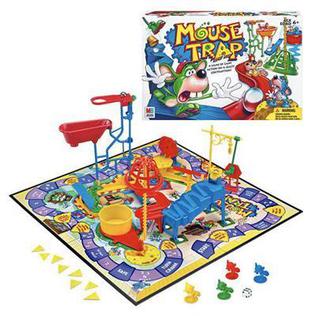
Mouse Trap is a board game first published by Ideal in 1963 for two to four players. It is one of the first mass-produced three-dimensional board games. Players at first cooperate to build a working mouse trap in the style of a Rube Goldberg machine. Then, players turn against each other to trap opponents' mouse-shaped game pieces.
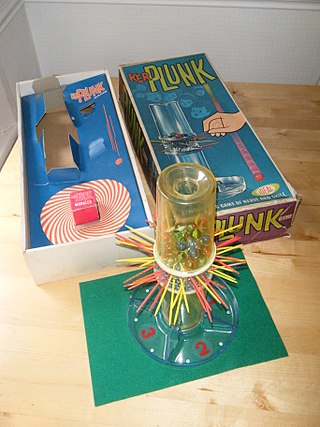
KerPlunk is a children's game invented by Eddy Goldfarb with Rene Soriano and first marketed by the Ideal Toy Company in 1967. The game consists of a transparent plastic tube, plastic rods called straws and several dozen marbles. The base contains four separate numbered trays; the straws are passed through holes in the middle of the tube to form a lattice. The marbles are then placed in the top of the tube and held in place by the lattice. The onomatopoeic name of the game derives from the sound of the marbles tumbling to the base of the tube during play.

Ravensburger AG is a German game, puzzle and toy company, publishing house, and leader in the European jigsaw puzzle market.
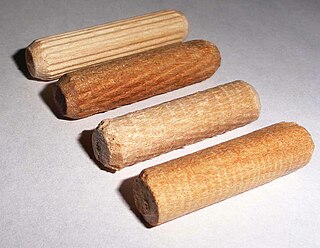
A dowel is a cylindrical shape made of wood, plastic, or metal. In its original manufactured form, a dowel is long and called a dowel rod, which are often cut into shorter dowel pins. Dowels are commonly used as structural reinforcements in cabinet making and in numerous other applications, including:
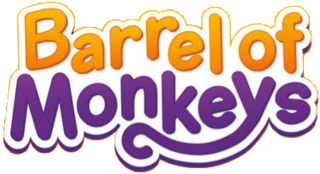
Barrel of Monkeys is a toy game released by Lakeside Toys in 1965. It was created by Leonard Marks and Milton Dinhofer in 1961, and in 1964, Herman Kesler partnered to sell it to Lakeside Toys, which released it in 1965. It was then produced by the Milton Bradley Company, and Hasbro. Milton Bradley's editions consisted of a toy barrel in either blue, yellow, red, purple, orange, gray or green. The barrel contains 13 monkeys but can hold 24, their color usually corresponding to the barrel's color. The instructions state, "Dump monkeys onto table. Pick up one monkey by an arm. Hook other arm through a second monkey's arm. Continue making a chain. Your turn is over when a monkey is dropped." In addition to these basic instructions, the barrel also contains instructions for playing alone or with two or more players.

Selchow and Righter was a 19th- and 20th-century game manufacturer best known for the games Parcheesi and Scrabble. It was based in Bay Shore, New York.

Pichenotte refers to a family of several disk-flicking games, mostly French Canadian in origin, including crokinole, pitchnut, and North American carrom, which may sometimes be played with small cue sticks. Pichenotte is a Canadian French word meaning 'flick', which is derived from the European French word pichenette, also meaning 'flick'. These folk games are in the public domain, and are not subject to copyright like a commercial board game. Nor are they patented games. However, the names Pichenotte and Pitchnut are registered trademarks in the United States. The game community site Knipsbrat.com states that, like the German name Knipsbrat ('flicking-board'), "pichenotte is another name for crokinole" The Canadian game board collection at the Quebec Museum of Civilization in Quebec City includes both the square carrom-type board and the round crokinole-type game Crokinole is also called pichenotte throughout much of North America. Modern-day tournaments have been held as far apart as Tavistock, Ontario, and Santa Fe and Albuquerque, New Mexico.

Articulate! is a board game from Drumond Park, for 4 to 20+ players aged 12 and up with original concept by Andrew Bryceson. Articulate! players describe words from six different categories to their team as quickly as possible. The teams move round the board based on the number of words correctly guessed and occasional spinner bonuses. The object of the game is to be the first team to get around the board to the finish space.
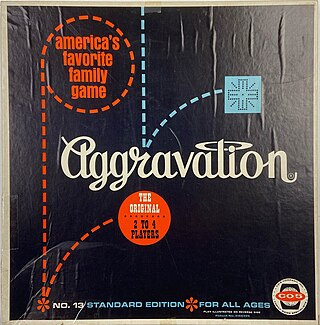
Aggravation is a board game for up to four players and later versions for up to six players, whose object is to be the first player to have all four playing pieces reach the player's home section of the board. The game's name comes from the action of capturing an opponent's piece by landing on its space, which is known as "aggravating". The name was coined by one of the creators, Louis Elaine, who did not always enjoy defeat.

Mall Madness is a shopping themed board game released by Milton Bradley in 1988.
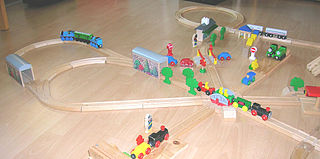
Wooden toy trains are toy trains that run on a wooden track system with grooves to guide the wheels of the rolling stock. While the trains, tracks and scenery accessories are made mainly of wood, the engines and cars connect to each other using metal hooks or small magnets, and some use plastic wheels mounted on metal axles. Some trains are made to resemble anthropomorphical, fictional, and prototypical railroad equipment.

CirKis is a piece placing board game, for two to four players, invented by Phil E. Orbanes and developed by Winning Moves Games USA in 2008. However, the game is no longer in production. The game is based on a Penrose tiling.


























